washer fluid CHEVROLET S10 1995 2.G Owners Manual
[x] Cancel search | Manufacturer: CHEVROLET, Model Year: 1995, Model line: S10, Model: CHEVROLET S10 1995 2.GPages: 354, PDF Size: 18.92 MB
Page 82 of 354
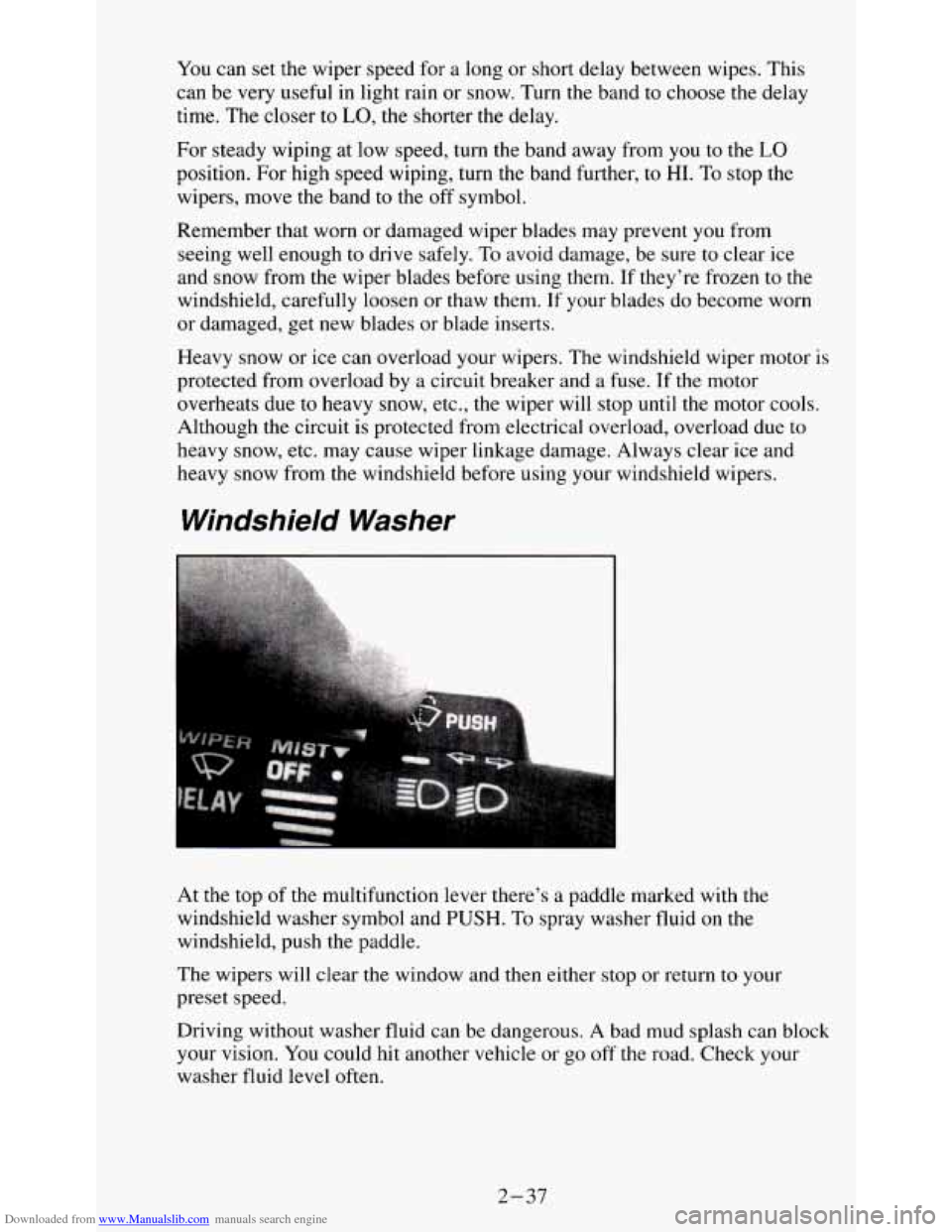
Downloaded from www.Manualslib.com manuals search engine You can set the wiper speed for a long or short delay between wipes. This
can be very useful in light rain or snow. Turn
the band to choose the delay
time. The closer
to LO, the shorter the delay.
For steady wiping at low speed, turn the band away from you to the
LO
position. For high speed wiping, turn the band further, to HI. To stop the
wipers, move the band to the
off symbol.
Remember that worn or damaged wiper blades may prevent
you from
seeing well enough to drive safely.
To avoid damage, be sure to clear ice
and snow from the wiper blades before using them. If they’re frozen to the
windshield, carefully loosen or thaw them. If your blades do become worn
or damaged, get new blades or blade inserts.
Heavy snow or ice can overload your wipers. The windshield wiper motor is
protected from overload by a circuit breaker and a fuse. If the motor
overheats due
to heavy snow, etc., the wiper will stop until the motor cools.
Although the circuit is protected from electrical overload, overload due to
heavy snow, etc. may cause wiper linkage damage. Always clear ice and
heavy snow from the windshield before using your windshield wipers.
Windshield Washer
At the top of the multifunction lever there’s a paddle marked with the
windshield washer symbol and
PUSH. To spray washer fluid on the
windshield, push the paddle.
The wipers will clear the window and then either stop or return
to your
preset speed.
Driving without washer fluid can be dangerous. A bad mud splash can block
your vision. You could hit another vehicle or go
off the road. Check your
washer fluid level often.
2-37
Page 83 of 354
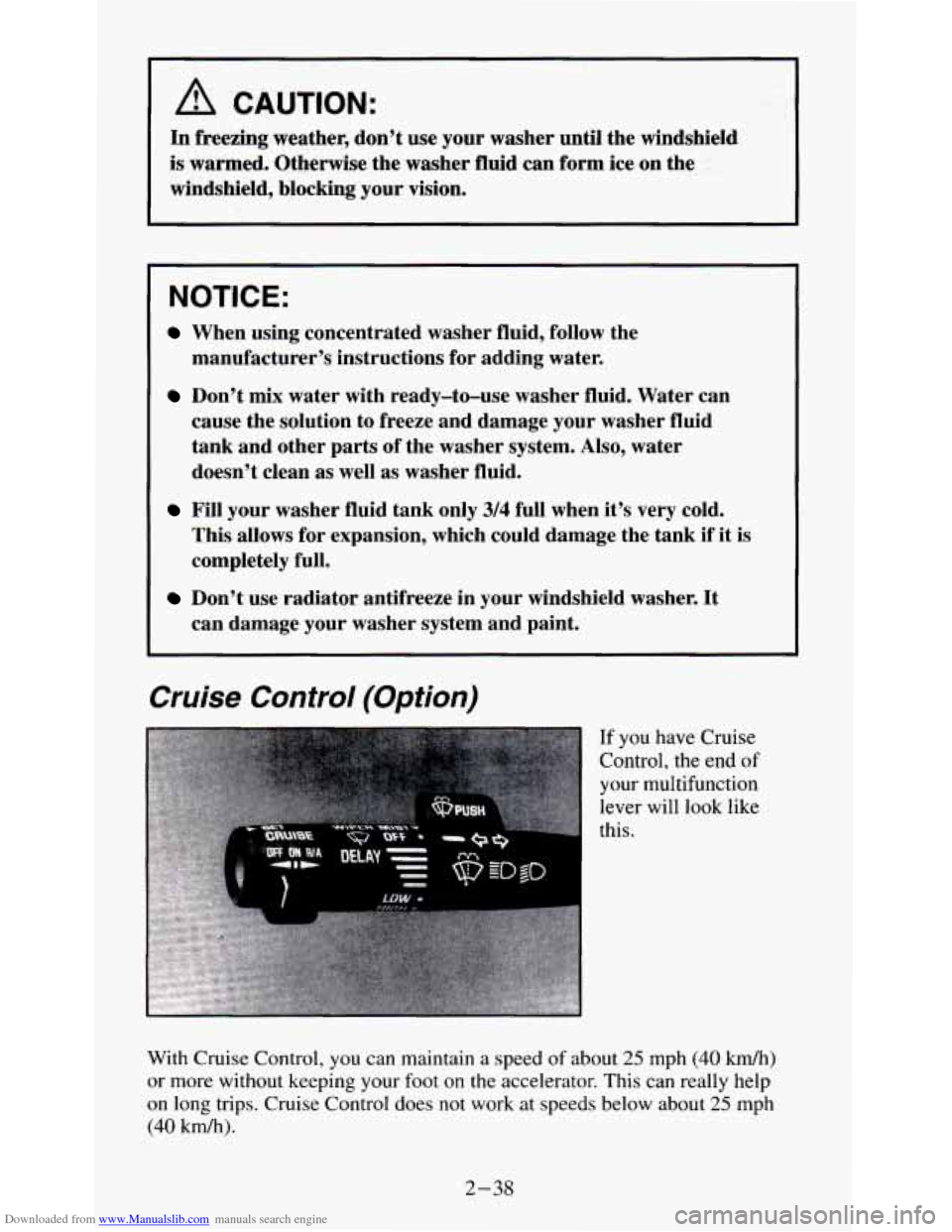
Downloaded from www.Manualslib.com manuals search engine A CAUTION: I
In freezing weather, don’t use your washer until the windshield
is warmed. Otherwise the washer fluid can form ice on the
windshield, blocking your vision.
I
NOTICE:
When using concentrated washer fluid, follow the
manufacturer’s instructions for adding water.
Don’t mix water with ready-to-use washer fluid. Water can
cause the solution to freeze and damage your washer fluid
tank and other parts of the washer system. Also, water
doesn’t clean
as well as washer fluid.
Fill your washer fluid tank only 3/4 full when it’s very cold.
~ This allows for expansion, which could damage the tank if it is
completely full.
Don’t use radiator antifreeze in your windshield washer. It
can damage your washer system and paint.
Cruise Control (Option)
If you have Cruise
Control, the end
of
your multifunction
lever will
look like
this.
With Cruise Control,
you can maintain a speed of about 25 mph (40 kdh)
or more without keeping your foot on the accelerator. This can really help
on long trips. Cruise Control does not work at speeds below about 25 mph
(40 km/h).
2-38
Page 162 of 354

Downloaded from www.Manualslib.com manuals search engine The exit ramp can be curved, sometimes quite sharply.
The
exit speed is usually posted.
Reduce your speed according to your speedometer, not
to your sense of
motion. After driving for any distance at higher speeds, you may tend to
think you are going slower than you actually are.
Before Leaving on a Long Trip
Make sure you’re ready. Try to be well rested. If you must start when you’re
not fresh
- such as after a day’s work - don’t plan to make too many
miles that first part of the journey. Wear comfortable clothing and shoes you
can easily drive
in.
Is your vehicle ready for a long trip? If you keep it serviced and maintained,
it’s ready to
go. If it needs service, have it done before starting out. Of
course, you’ll find experienced and able service experts in GM dealerships
all across North America. They’ll be ready and willing to help if you need
it.
Here are some things you can check before a trip:
Windshield Washer Fluid: Is the reservoir full? Are all windows clean
inside and outside?
Wiper Blades: Are they in good shape?
Fuel, Engine Oil, Other Fluids: Have you checked all levels?
Lights: Are they all working? Are the lenses clean?
0 Tires: They are vitally important to a safe, trouble-free trip. Is the tread
good enough for long-distance driving? Are the tires all inflated to the
recommended pressure?
Weather Forecasts: What’s the weather outlook along your route?
Maps: Do you have up-to-date maps?
Should
you delay your trip a short time to avoid a major storm system?
Highway Hypnosis
Is there actually such a condition as “highway hypnosis”? Or is it just plain
falling asleep at the wheel? Call it highway hypnosis, lack of awareness, or
whatever.
There
is something about an easy stretch of road with the same scenery,
along with the hum of the tires on the road,
the drone of the engine, and the
rush of the wind against the vehicle that can make you sleepy. Don’t let it
happen to you! If it does, your vehicle can leave the road in
less than a
second,
and you could crash and be injured.
What can you
do about highway hypnosis? First, be aware that it can
happen.
4-29
Page 165 of 354

Downloaded from www.Manualslib.com manuals search engine Include an ice scraper, a small brush or broom, a supply of windshield
washer fluid, a rag, some winter outer clothing, a small shovel, a flashlight,
a red cloth, and a couple
of reflective warning triangles. And, if you will be
driving under severe conditions, include a small bag of sand, a piece of old
carpet
or a couple of burlap bags to help provide traction. Be sure you
properly secure these items in your vehicle.
Driving on Snow or Ice
Most of the time, those places where your tires meet the road probably have
good traction.
However, if there is snow
or ice between your tires and the road, you can
have a very slippery situation. You’ll have a lot less traction or “grip” and
will need to be very careful.
What’s the worst time for this? “Wet ice.” Very cold snow or ice can
be
slick and hard to drive on. But wet ice can be even more trouble because it
may offer the least traction
of all. You can get “wet ice” when it’s about
freezing
(32 OF; OOC) and freezing rain begins to fall. Try to avoid driving
on wet ice until salt and sand crews can get there.
Whatever the condition
- smooth ice, packed, blowing or loose snow -
drive with caution.
Accelerate gently. Try not to break the fragile traction.
If you accelerate too
fast,
the drive wheels will spin and polish the surface under the tires even
more.
4-32
Page 242 of 354
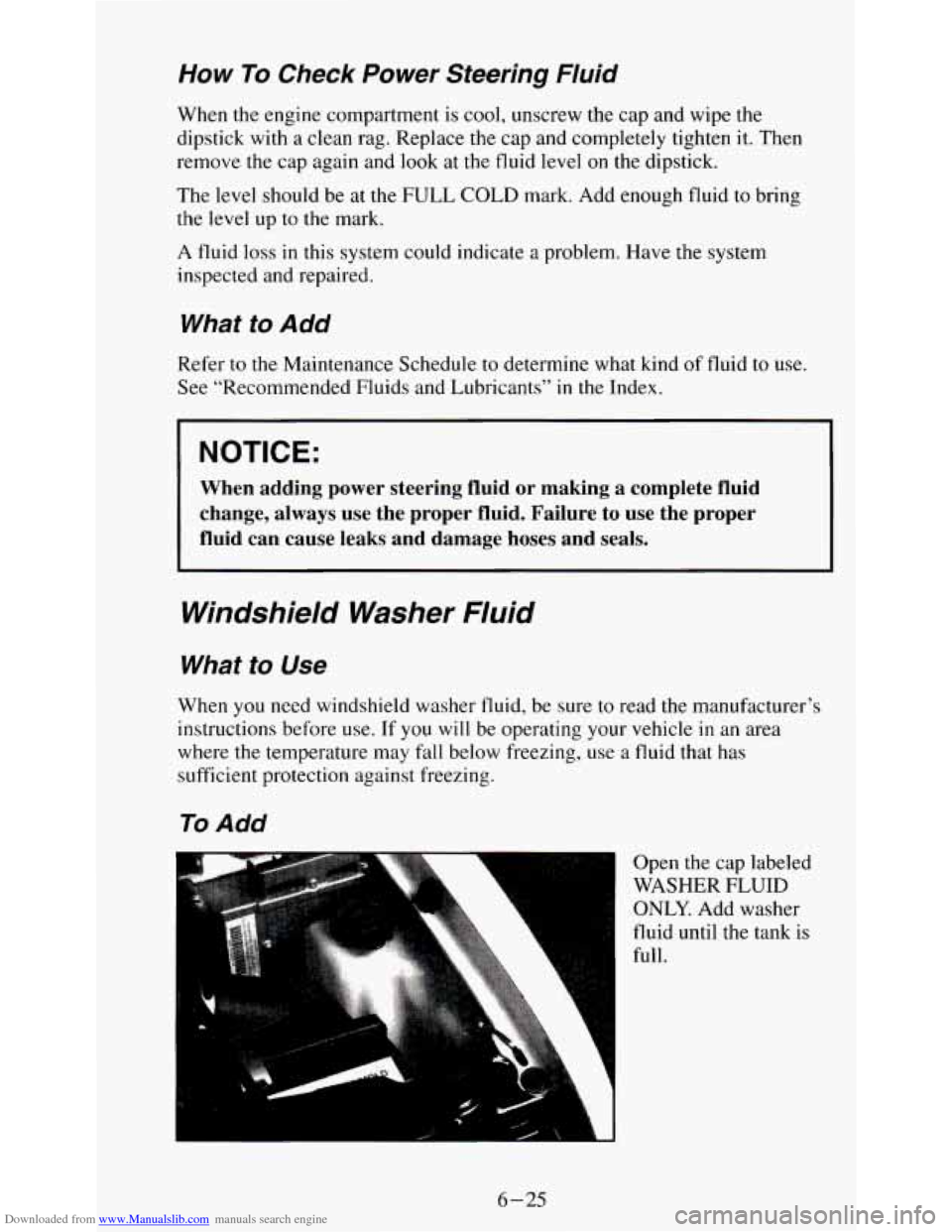
Downloaded from www.Manualslib.com manuals search engine How To Check Power Steering Fluid
When the engine compartment is cool, unscrew the cap and wipe the
dipstick with a clean rag. Replace
the cap and completely tighten it. Then
remove the cap again and look at the fluid level
on the dipstick.
The
level should be at the FULL COLD mark. Add enough fluid to bring
the level up to the mark.
A fluid loss
in this system could indicate a problem. Have the system
inspected and repaired.
What to Add
Refer to the Maintenance Schedule to determine what kind of fluid to use.
See "Recommended Fluids and Lubricants"
in the Index.
NOTICE:
When adding power steering fluid or making a complete fluid
change, always use the proper fluid. Failure to use the proper
fluid can cause leaks and damage hoses and seals.
Windshield Washer Fluid
What to Use
When you need windshield washer fluid, be sure to read the manufacturer's
instructions before use. If you will be operating your vehicle in an area
where
the temperature may fall below freezing, use a fluid that has
sufficient protection against freezing.
t
L
To Add
Open the cap labeled
WASHER
FLUID
ONLY. Add washer
fluid until
the tank is
full.
L
L
t
6-25
Page 243 of 354
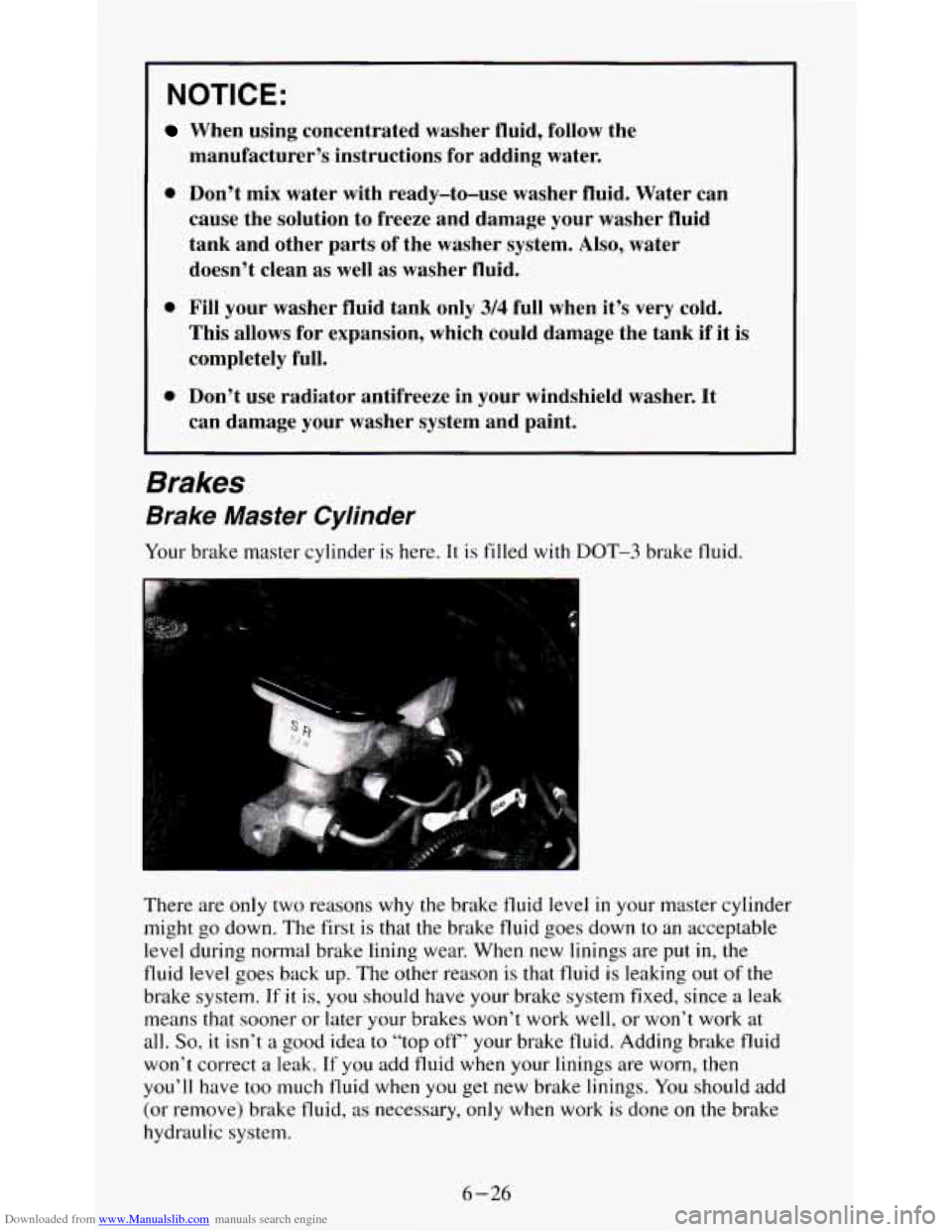
Downloaded from www.Manualslib.com manuals search engine NOTICE:
When using concentrated washer fluid, follow the
manufacturer’s instructions for adding water.
0 Don’t mix water with ready-to-use washer fluid. Water can
cause the solution to freeze and damage your washer fluid
tank and other parts of the washer system.
Also, water
doesn’t clean
as well as washer fluid.
0 Fill your washer fluid tank only 314 full when it’s very cold.
This allows for expansion, which could damage the tank if it is
completely full.
0 Don’t use radiator antifreeze in your windshield washer. It
can damage your washer system and paint.
Brakes
Brake Master Cylinder
Your brake master cylinder is here. It is filled with DOT-3 brake fluid.
~~
There are only two reasons why the brake fluid level in your master cylinder
might go down. The first
is that the brake fluid goes down to an acceptable
level during normal brake lining wear. When new linings are put in, the
fluid level goes back
up. The other reason is that fluid is leaking out of the
brake system.
If it is, you should have your brake system fixed, since a leak
means that sooner or later your brakes won’t work well, or won’t work at
all. So, it isn’t
a good idea to “top off’ your brake fluid. Adding brake fluid
won’t correct a leak.
If you add fluid when your linings are worn, then
you’ll have
too much fluid when you get new brake linings. You should add
(or remove) brake fluid,
as necessary, only when work is done on the brake
hydraulic system.
6-26
Page 269 of 354
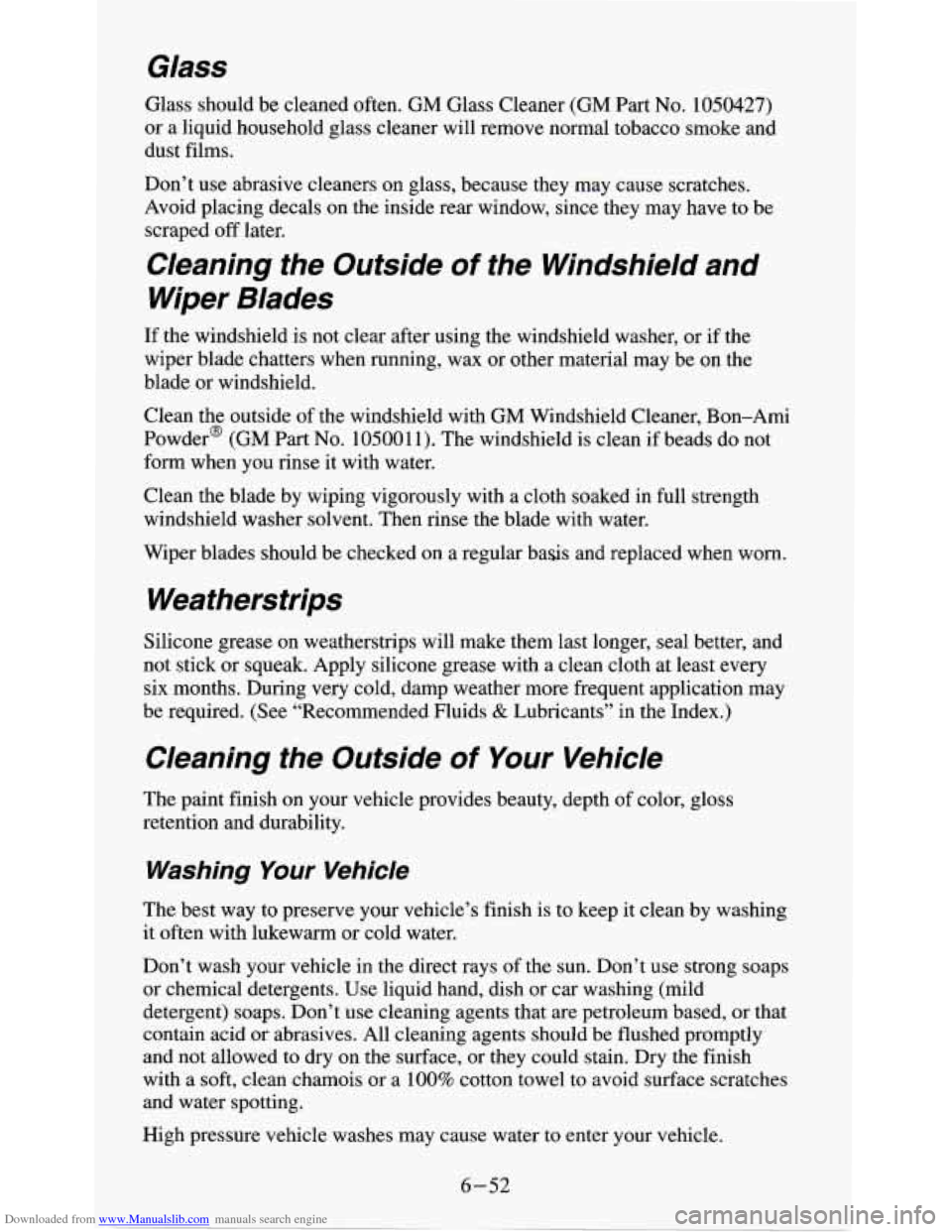
Downloaded from www.Manualslib.com manuals search engine Glass
Glass should be cleaned often. GM Glass Cleaner (GM Part No. 1050427)
or a liquid household glass cleaner will remove normal tobacco smoke and
dust films.
Don’t use abrasive cleaners on glass, because they may cause scratches.
Avoid placing decals on the inside rear window, since they may have to be
scraped
off later.
Cleaning the Outside of the Windshield and
Wiper Blades
If the windshield is not clear after using the windshield washer, or if the
wiper blade chatters when running, wax or other material may be on the
blade or windshield.
Clean the outside
of the windshield with GM Windshield Cleaner, Bon-Ami
Powder@
(GM Part No. 105001 1). The windshield is clean if beads do not
form when you rinse it with water.
Clean the blade by wiping vigorously with a cloth soaked
in full strength
windshield washer solvent. Then rinse the blade with water.
Wiper blades should be checked on a regular basis and replaced when worn.
Weatherstrips
Silicone grease on weatherstrips will make them last longer, seal better, and
not stick or squeak. Apply silicone grease with a clean cloth at least every
six months. During very cold, damp weather more frequent application may
be required. (See “Recommended Fluids
& Lubricants” in the Index.)
Cleaning the Outside of Your Vehicle
The paint finish on your vehicle provides beauty, depth of color, gloss
retention and durability.
Washing Your Vehicle
The best way to preserve your vehicle’s finish is to keep it clean by washing
it often with lukewarm or cold water.
Don’t wash your vehicle in the direct rays of the sun. Don’t use strong soaps
or chemical detergents.
Use liquid hand, dish or car washing (mild
detergent) soaps. Don’t use cleaning agents that are petroleum based, or that
contain acid
or abrasives. All cleaning agents should be flushed promptly
and not allowed to dry on the surface, or they could stain. Dry the finish
with a soft, clean chamois or a
100% cotton towel to avoid surface scratches
and water spotting.
High pressure vehicle washes may cause water to enter your vehicle.
6-52
Page 323 of 354
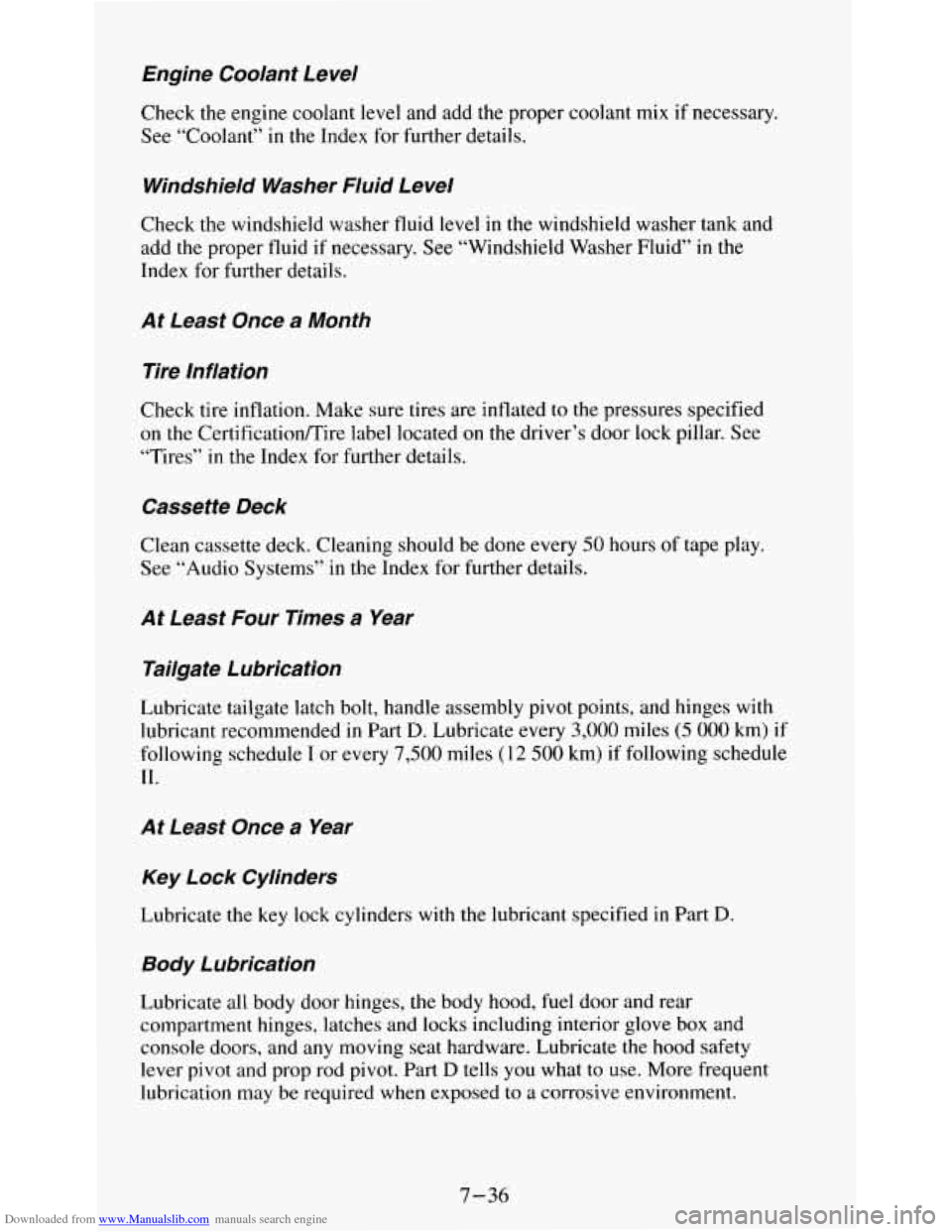
Downloaded from www.Manualslib.com manuals search engine Engine Coolant Level
Check the engine coolant level and add the proper coolant mix if necessary.
See “Coolant”
in the Index for further details.
Windshield Washer Fluid Level
Check the windshield washer fluid level in the windshield washer tank and
add the proper fluid
if necessary. See “Windshield Washer Fluid” in the
Index for further details.
At Least Once a Month
Tire Inflation
Check tire inflation. Make sure tires are inflated to the pressures specified
on
the CertificatiodTire label located on the driver’s door lock pillar. See
“Tires” in the Index for further details.
Cassette Deck
Clean cassette deck. Cleaning should be done every 50 hours of tape play.
See “Audio Systems” in the Index for further details.
At Least Four Times a Year
Tailgate Lubrication
Lubricate tailgate latch bolt, handle assembly pivot points, and hinges w\
ith
lubricant recommended
in Part D. Lubricate every 3,000 miles (5 000 km) if
following schedule
I or every 7,500 miles (1 2 500 km) if following schedule
11.
At Least Once a Year
Key Lock Cylinders
Lubricate the key lock cylinders with the lubricant specified in Part D.
Body Lubrication
Lubricate all body door hinges, the body hood, fuel door and rear
compartment hinges, latches and locks including interior glove
box and
console doors, and any moving seat hardware. Lubricate the hood safety
lever pivot and prop rod pivot. Part D tells you what to use. More frequent
lubrication may be required when exposed to a corrosive environment.
7-36
Page 328 of 354
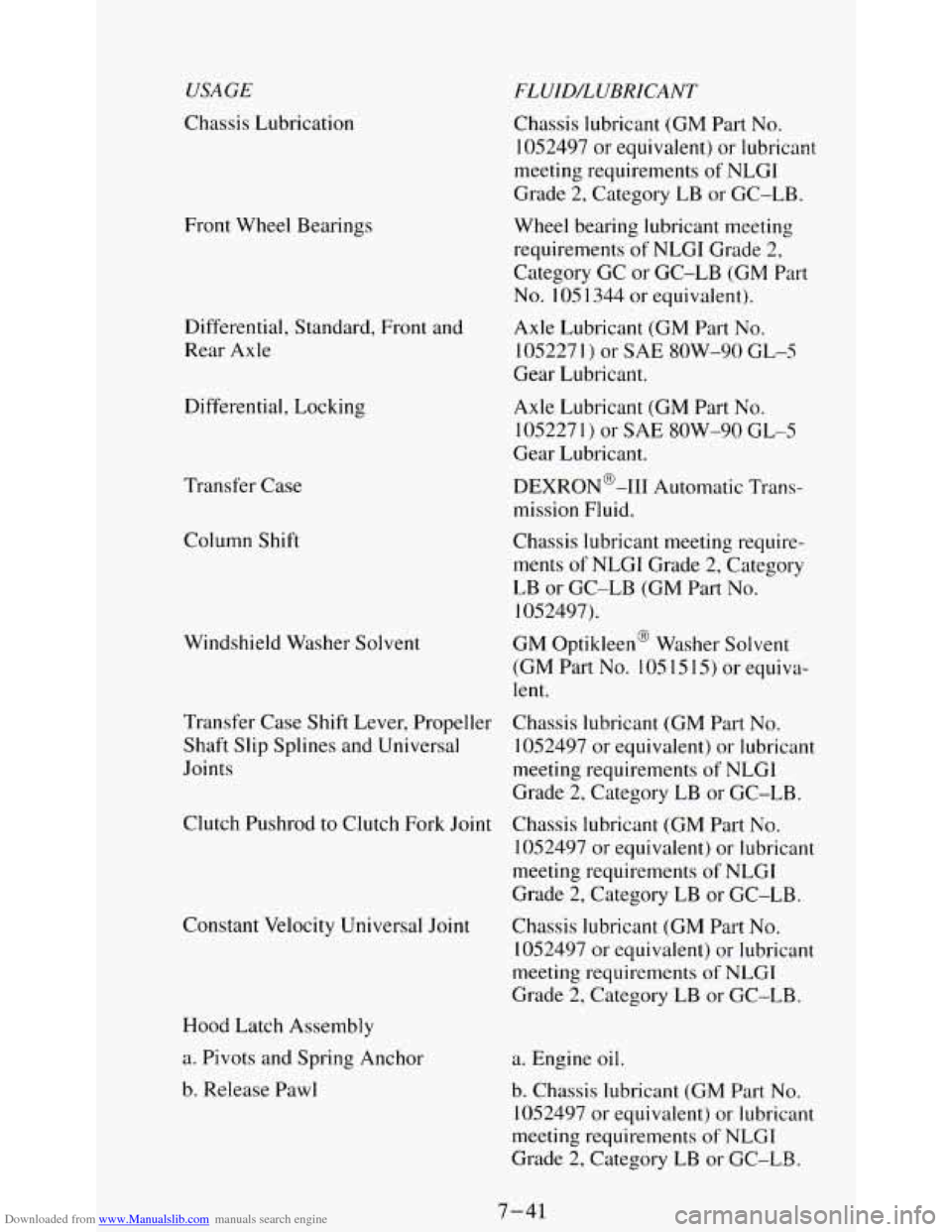
Downloaded from www.Manualslib.com manuals search engine USAGE
Chassis Lubrication
Front Wheel Bearings
Differential, Standard, Front and
Rear Axle
Differential, Locking
Transfer Case
Column Shift
Windshield Washer Solvent
FLUID/LUBRICANT
Chassis lubricant (GM Part No.
1052497 or equivalent) or lubricant
meeting requirements of NLGI
Grade
2, Category LB or GC-LB.
Wheel bearing lubricant meeting
requirements of NLGI Grade
2,
Category GC or GC-LB (GM Part
No. 105 1344 or equivalent).
Axle Lubricant (GM Part
No.
105227 1 ) or SAE SOW-90 GL-5
Gear Lubricant.
Axle Lubricant (GM Part
No.
1052271) or SAE SOW-90 GL-5
Gear Lubricant.
DEXRON@-111 Automatic Trans-
mission Fluid.
Chassis lubricant meeting require-
ments
of NLGI Grade 2, Category
LB or GC-LB (GM Part No.
1052497).
GM Optikleen@ Washer Solvent
(GM Part No.
105 15 15) or equiva-
lent.
Transfer Case Shift Lever, Propeller
Chassis lubricant (GM Part
No.
Shaft Slip Splines and Universal
I052497 or equivalent) or lubricant
Joints meeting requirements
of NLGl
Grade 2, Category LB or GC-LB.
Clutch Pushrod to Clutch Fork Joint Chassis lubricant (GM Part
No.
1052497 or equivalent) or lubricant
meeting requirements
of NLGI
Grade 2, Category LB or GC-LB.
Constant Velocity Universal
Joint Chassis lubricant (GM Part No.
1052497 or equivalent)
or lubricant
meeting requirements
of NLGI
Grade 2, Category LB or GC-LB.
Hood Latch Assembly
a. Pivots and Spring Anchor
b. Release Pawl a.
Engine
oil.
b. Chassis lubricant (GM Part No.
1052497 or equivalent) or lubricant
meeting requirements
of NLGT
Grade 2, Category LB or GC-LB.
7-41
Page 353 of 354

Downloaded from www.Manualslib.com manuals search engine Winches ....................................................... 4-35
Windows
...................................................... 2-32
SlidingRear
................................................. 2-33
Swing-Out Windows (Extended Cab)
............................. 2-33
Washer
...................................................... 2-37
WasherFluid
................................................. 6-25
Wiper ....................................................... 2-36
Windshield
Wiper Blade Chatter
........................................... 6-52
WiperBladeCleaning
.......................................... 6-52
Wiper Blade Replacement
...................................... 6-36
10